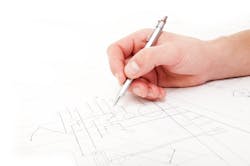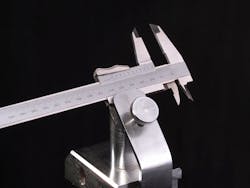Avoiding Problems with Dimensional Tolerances
This article was updated Feb. 13, 2023. It was originally published May 10, 2012.
READ MORE: Avoiding Design Problems with Geometric Dimensioning and Tolerancing
Dimensional tolerances are critical for making parts that will fit together in an assembly and meet the design and performance goals. Getting the tolerances wrong could easily mean parts will be too expensive to make or will not fit properly with other components.
For example, if an engineering team designed a 0.875-in. diameter shaft that was supposed to mate with a precision bearing, but it sent out the drawings to a reputable manufacturer without specifying tolerances, the bearing may or may not fit on the finished shaft.
But how could this happen?
Machine shops that see an untoleranced diameter on a part and do not know the design intent may typically apply a standard tolerance for three-decimal-place untoleranced dimensions, ±0.005 in. Unfortunately, this means the shaft may be too large for the hole it is designed to slide through. The machine shop will gladly rework the pieces to fit—for an additional charge—which will extend delivery times and possibly lead to missed deadlines and budgets.
Make no mistake, this happens all the time. Many machine shops take the extra step of verifying untoleranced dimensions, but many others don’t. Engineers who know the importance of tolerances, and how to use them, can easily avoid this problem.
Tolerance Basics
ASME Y14.5M defines “tolerance” as “the total amount a specific dimension is permitted to vary. The tolerance is the difference between the maximum and minimum limits. This can be shown as upper and lower limits (0.2500/0.2498) or an allowable amount above and below a nominal dimension (0.2499 ±0.0001). Both methods define the same range—the tolerable band—of allowable dimensions rejected. The larger the difference between the upper and lower limits, the larger the tolerance band and the “looser” the tolerance. Conversely, a smaller tolerance band is considered a “tighter” tolerance.
READ MORE: Fundamentals of Ultraprecision Machining
Engineers should always use tolerances. Ambiguity is not a friend to mechanical designers. If dimension has no defined tolerance, no one will know the importance, or unimportance, of the dimension except the designer.
Benefits
Tolerances ensure parts will fit properly and work as designed within an assembly whether it is uses a sliding or press fit. They also reduce costs. Unnecessarily tight tolerances make parts more expensive. And there is no reason to apply a ±0.0002 tolerance when ±0.002 will do. Also, although some manufacturers apply their own standard tolerances to untoleranced dimensions, many will not even begin making parts until all features are defined.
Expecting parts to be made to the machinist’s best effort is not realistic. The machinist does not know how parts interact, nor is that their responsibility. Furthermore, one machinist’s “best effort” may be maintaining features to within a few ten-thousandths of the dimension indicated, while another may make the feature 0.015 in. larger or smaller than indicated.
Tolerances should not be used without hesitation. Don’t think that just because a larger tolerance band is used, it means parts will be sloppily made. In fact, depending on the manufacturer’s standards, shipped parts might have even tighter tolerances than originally specified.
Another significant benefit is that by using suitable tolerances, engineers pass the responsibility of making the part correctly to the manufacturer. By the same token, if the part is within tolerance but doesn’t fit or function properly, the manufacturer cannot be held accountable. Dimensions without tolerances leave the acceptable limits open, and it’s not the manufacturer’s responsibility to determine what is acceptable.
Considerations
One of the most critical considerations when applying tolerances is to take into account fits. This refers to how shafts fit into bearings or bushings, how motors fit into pilot holes and so on. There are three basic types of fits: Clearance fits can compensate for thermal expansion, sliding fits provide better positioning; and interference (press)s have higher for holding capability. (For more information, check out Machinery’s Handbook.)
Another consideration is how “tolerance accumulation” (also called “tolerance stack”) affects a part. Consider a piece of equipment assembled from several different components, each with its own tolerances. If every part is at the low (small) end of its tolerance window or, conversely, very one is at its high (large end), will the machine still go together? Engineers must keep the final product in mind when they are setting tolerances.
Be careful when applying tolerances to a radius or diameter. Tolerances on a radius will double when measured as a diameter. The tolerances on a radius might be looser than intended, while the one on a diameter might be tighter than intended.
Also, one need not assume measurements will be rounded when determining if a part conforms to its specified tolerance. If a part measured with a micrometer registers 0.2502, and the part’s dimension is supposed to be 0.250 +0.000/−0.002 the dimension is not rounded down to three decimal places; it is considered nonconforming. ASME Y14.5M states dimensions “are used as if they were continued with zeros,” even if not shown.
READ MORE: Optimized Tolerances Make Good Products Better
Also take into account plating and finishing processes the part may undergo. A note should indicate if dimensions apply before or after such processes.
When using either MIN or MAX limits, ensure that if the dimension approaches infinity (in the case of MIN) or is zero (in the case of MAX), it does detract from the part’s design.
Both the location and size of alignment holes (such as for dowel pins) should not carry the same tolerances as clearance holes (such as for screws to pass through). If the dowel pin hole is too far from the desired spot (outside proper tolerances), it might make the parts impossible to assemble. The same level of an out-of-bound tolerance on clearance hole, however, will likely have effect to the assembly, except possibly a near-imperceptible aesthetic oddity.
Thoroughly dimensioning parts is important, but avoid redundancies. They can cause conflicts in inspection because certain features are defined more than once and in different ways. If a designer wants an over-defined dimension, they should use a reference dimension between parentheses and usually without tolerances.
Dimensional tolerances are key to making parts right. Using them appropriately saves time spent talking with the manufacturer, avoids design issues and reduces costs.
Stefan Menin was a design engineer at Ondrives US when this article was first published.

